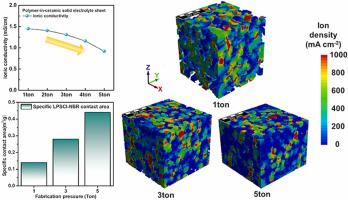Nano Energy ( IF 16.8 ) Pub Date : 2022-08-06 , DOI: 10.1016/j.nanoen.2022.107679 Hoiju Choi , Minjae Kim , Hyobin Lee , Seungwon Jung , Young-Gi Lee , Yong Min Lee , Kuk Young Cho

|
Among the next-generation battery technologies, all-solid-state lithium batteries (ASLBs) are the most attractive because of the high safety and high energy density. The critical difference between ASLBs and conventional lithium-ion batteries (LIBs) is the replacement of the liquid electrolyte with a solid electrolyte (SE). Thus, for battery development, the investigation of ionic conductivities of SEs is essential. Sulfide-type ion conductors are representative SEs having high ionic conductivities and are ductile. However, sulfide-type SEs suffers from H2S gas release and degradation when exposed to the moisture in the air, and, as a result, the study and optimization of the fabrication parameters is challenging. In this study, we fabricated a polymer-in-ceramic SE as a thin, large-area, free-standing SE. Crucially, to optimize the fabrication conditions, we used a model inorganic particles that do not suffer from the moisture sensitivity typical of sulfide-based SEs. Interestingly, the ionic conductivity of the polymer-in-ceramic SE changed with applied pressure, behavior unlike that of a conventional pellet-type SEs prepared from sulfide powders. To understand this phenomenon, we carried out digital twinned 3D structure simulation analysis, which revealed changes in the specific contact area and distribution of ionic density in the polymer-in-ceramic SE. As a result, we propose a model composition that will facilitate the exploration of polymer-in-ceramic SEs and their characteristics and, thus, enhance the practical use of ASLBs.
中文翻译:

用于全固态电池的硫化物基聚合物陶瓷固体电解质的意外压力效应
在下一代电池技术中,全固态锂电池(ASLB)因其高安全性和高能量密度而最具吸引力。ASLB 与传统锂离子电池 (LIB) 之间的关键区别在于用固体电解质 (SE) 代替液体电解质。因此,对于电池的开发,研究 SE 的离子电导率是必不可少的。硫化物型离子导体是具有高离子电导率且具有延展性的代表性 SE。然而,硫化物型SEs遭受H 2当暴露于空气中的水分时,S 气体释放和降解,因此,制造参数的研究和优化具有挑战性。在这项研究中,我们将陶瓷中的聚合物 SE 制造为薄的、大面积的、独立的 SE。至关重要的是,为了优化制造条件,我们使用了一种模型无机颗粒,它不受硫化物基 SE 典型的湿度敏感性的影响。有趣的是,陶瓷中聚合物 SE 的离子电导率随施加的压力而变化,其行为不同于由硫化物粉末制备的传统颗粒型 SE。为了理解这种现象,我们进行了数字孪生 3D 结构模拟分析,揭示了陶瓷中聚合物 SE 中特定接触面积和离子密度分布的变化。因此,











































 京公网安备 11010802027423号
京公网安备 11010802027423号